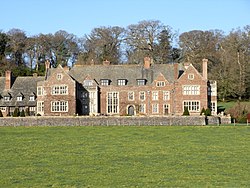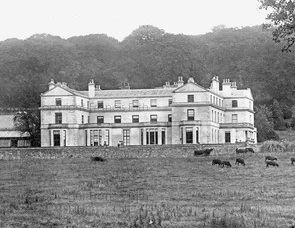Creedy Park
| Creedy Park | |
| Devon | |
|---|---|
 Creedy House | |
| Location | |
| Grid reference: | SS83230164 |
| Location: | 50°48’9"N, 3°39’30"W |
| Village: | Sandford |
| History | |
| Built 1916-21 | |
| Country house | |
| Information | |
Creedy House is a fine country house within the historic Creedy estate in the parish of Sandford, near Crediton in Devon. The estate is named from its location on the west side of the River Creedy.
Creedy was the seat of the Davie family (created Davie baronets in 1641) from about 1600[1] until the late 20th century. The mansion house on the estate has been called at various times New House, Creedy House, and as at present, Creedy Park. It was first built in about 1600 and rebuilt in 1846, but burnt down in 1915. The house was rebuilt in a new style between 1916 and 1921.
The house is surrounded by a large park, the boundary of which is enclosed by a stone and brick wall several miles long.

Location
According to the early seventeenth century Devon historians William Pole and Tristram Risdon, anciently several different estates named "Creedy" existed within West Budleigh Hundred[2] in the general area of the River Creedy near or in the parishes of Sandford, on the west side of the river, and Shobrooke, on the east side of the river. It is not possible to identify today's estate with certainty to one of these ancient estates.
'Creedy Hilion' was an estate which Pole states to have been held by the Hilion family of Asheriston[3] (Ashton[4]) until at least the reign of King Edward III (1327–1377). It then passed to the Dowrish family, of Dowrish in the parish of Sandford and by various sales and inheriatnces down the ages it came to be bought by Walter Yonge (1579–1649),[3] the Member of Parliament for Honiton, of Upton Hilion, who held it in Pole's time.
'Creedy Peitevin' was held by the Peitevin or Peytevin family until the reign of King Henry III (1216–1272), when it passed by an heiress to Sir John Wiger and then by various inheritances and sales it came to Sir William Peryam (1534–1604), of Little Fulford, on the east side of the River Creedy. Pole writes with great authority on this subject, as his first wife was Sir William's daughter, Mary Peryam. Concerning Creedy Wiger in his own day he wrote that Peryam "bwilt theire a fayre dwellinge howse & left it to descend unto his fowre daughters, Mary my wife..." etc.[5] It is well established however that the house Peryam built and lived at was Little Fulford, in the parish of Shobrooke, which Pole thus seems to make identical with Creedy Wiger.
History
John Davie (1541/2-1611/2) of Exeter,[6] Crediton[7] and Creedy, was the fourth son of Robert Davie (d. circa 1570), a wealthy cloth merchant of Crediton.[8] He was three times Mayor of Exeter, in 1584, 1594 and 1604,[9] and in about 1600 built the first recorded mansion on the Creedy estate which was called "New House".[10] The early seventeenth century Devon historian Sir William Pole wrote concerning Credy:
Mr John Davy of Exceter hath bwilded a newe howse in this place & called it New-Howse unto wch hee added a fair demesnes wch hee hath left unto John Davy Esq his sonne & hath a mannor called Credy which adjoineth unto his demesnes".[6]
Davie married twice, by his first wife he left no issue, as his second wife he married Margaret Southcott, daughter of George Southcott of Calverleigh,[11] Devon,[8] second son of John Southcott (died 1556) of Indio in the parish of Bovey Tracey, Devon,[12] by whom he had a son and heir Sir John Davie, 1st Baronet (died 1654) and a daughter Margaret Davie, wife of Gideon Haydon of Cadhay, Epford and Woodbury.[13]
He founded two alms houses, one in the parish of St Mary Arches, Exeter, and another in Crediton, each for relief of two poor men and their wives, and two single persons.[14] His monument survives in St Mary Arches church in Exeter.
On the death of the 10th Baronet in 1846, the heir to Creedy and his other estates was his niece, Frances Juliana Davie (1802–1882), 2nd daughter of the 8th Baronet and wife of General Henry Robert Ferguson (1797–1885), MP for Haddington from 1847 to 1878. In 1846, in accordance with the terms of the 10th Baronet's will, he adopted by royal licence the surname and arms of Davie in addition to his patronymic, and was created a baronet on 9 January 1847. The new Sir Henry Robert Ferguson Davie rebuilt Creedy House in 1846. His eldest son Henry Davie Ferguson-Davie (1825–1850), a lieutenant in the Rifle Brigade, predeceased him, and is the subject of a monument on the south chancel wall in Sandford Church.
Twentieth century
The house has descended for several centuries through the baronets of the Davie family.
In November 1915, during the ownership of Sir William Augustus Ferguson Davie, 3rd Baronet, Creedy House burnt down.[15] In the same year Sir William was killed in action in Mesopotamia and the estate was inherited by his son, William John Ferguson Davie, who became the 4th Baronet. Sir William quickly set about rebuilding the house from 1916, though the shortage of labour during the Great War meant that work was slow initially, and the house was finall completed in 1921. It was built in a "conservative Jacobean" style, in dark stone which made it "rather forbidding".[16]
Rev. Sir (Arthur) Patrick Ferguson Davie, the 5th Baronet (1909–1988) was an honorary chaplain to the Bishop of Exeter, and Rural Dean of Cadbury, Devon. He commissioned the College of Arms to investigate whether he might be able to claim the abeyant Barony of Bardolph, but was advised that the Duke of Norfolk would have a stronger claim. In 1960 a banquet was held in the great hall for Princess Margaret, who stayed the night at Creedy Park as a guest of the 5th Baronet, after having unveiled a statue to St Boniface in Holy Cross Church, Crediton,[17] on Sunday 24 July 1960.
In 1982 Creedy House, having been sold, was converted into 13 residential units, and continues today in ownership of ten residents, with 15 acres of communal woodland. [15]
References
- ↑ Gray, Todd & Rowe, Margery (Eds.), Travels in Georgian Devon: The Illustrated Journals of The Reverend John Swete, 1789-1800, 4 vols., Tiverton, 1999, vol.3, p.121
- ↑ Pole, Sir William: 'Collections Towards a Description of the County of Devon' (Edition of 1791, pp.218, 221)
- ↑ 3.0 3.1 Pole, p.221
- ↑ Pole, p.255
- ↑ Pole, p.221
- ↑ 6.0 6.1 Pole, p.226
- ↑ Vivian, p.269 "Kirton", ancient name for Crediton
- ↑ 8.0 8.1 Vivian, p.269
- ↑ Mayors of Exeter
- ↑ Swete, vol.3, p.121
- ↑ Anciently Calwoodley, Callverley, etc.
- ↑ Vivian, p.697, pedigree of Southcott of Southcott; Pevsner, p.193, "Indio House"
- ↑ Vivian, p.459, pedigree of Haydon of Cadhay
- ↑ Prince, p.281
- ↑ 15.0 15.1 [1]
- ↑ Nikolaus Pevsner: The Buildings of England: Devon, 1952; 1989 Penguin Books ISBN 978-0-300-09596-8page 301
- ↑ Images of the Great Hall before the banquet: Andrew Webb in This is the West Country
- Vivian, Lt.Col. J.L., (Ed.) The Visitations of the County of Devon: Comprising the Heralds' Visitations of 1531, 1564 & 1620, Exeter, 1895, pp. 269–272, pedigree of Davie
- Risdon, Tristram (died 1640), Survey of Devon, 1811 edition, London, 1811, with 1810 Additions, p. 95
- Prince, John, (1643–1723) The Worthies of Devon, 1810 edition, London, pp. 281–284, biography of Davie, Edmund, Doctor of Physick (born 1630) (includes Davie ancestry)
Further reading
- Ferguson-Davie, Sir Michael, 8th Baronet, 'The Davies of Devon' (privately published)
- Webb, Andrew: 'Creedy Park: A Brief History in Pictures 1797-2012'